| Listing 1 - 10 of 15 | << page >> |
Sort by
|

ISBN: 0387004440 9780387004440 9780387216874 9786610188918 128018891X 0387216871 Year: 2004 Volume: 13 Publisher: New York Springer
Abstract | Keywords | Export | Availability | Bookmark
 Loading...
Loading...Choose an application
- Reference Manager
- EndNote
- RefWorks (Direct export to RefWorks)
Partial differential equations (PDEs) are fundamental to the modeling of natural phenomena, arising in every field of science. Consequently, the desire to understand the solutions of these equations has always had a prominent place in the efforts of mathematicians; it has inspired such diverse fields as complex function theory, functional analysis, and algebraic topology. Like algebra, topology, and rational mechanics, PDEs are a core area of mathematics. This book aims to provide the background necessary to initiate work on a Ph.D. thesis in PDEs for beginning graduate students. Prerequisites include a truly advanced calculus course and basic complex variables. Lebesgue integration is needed only in chapter 10, and the necessary tools from functional analysis are developed within the coarse. The book can be used to teach a variety of different courses. This new edition features new problems throughout, and the problems have been rearranged in each section from simplest to most difficult. New examples have also been added. The material on Sobolev spaces has been rearranged and expanded. A new section on nonlinear variational problems with "Young-measure" solutions appears. The reference section has also been expanded.
Partial differential equations --- Differential equations, Partial. --- Equations aux dérivées partielles --- Differential equations, Partial --- Mathematics --- Physical Sciences & Mathematics --- Calculus --- 517.95 --- 517.95 Partial differential equations --- Mathematics. --- Partial differential equations. --- Applied mathematics. --- Engineering mathematics. --- Physics. --- Partial Differential Equations. --- Applications of Mathematics. --- Mathematical Methods in Physics. --- Appl.Mathematics/Computational Methods of Engineering. --- Differential equations, partial. --- Mathematical physics. --- Mathematical and Computational Engineering. --- Natural philosophy --- Philosophy, Natural --- Physical sciences --- Dynamics --- Engineering --- Engineering analysis --- Mathematical analysis --- Differential equations. --- Differential Equations. --- Mathematical and Computational Engineering Applications. --- Data processing.
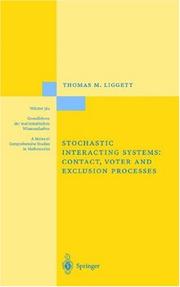
ISBN: 3540659951 3642085296 3662039907 Year: 1999 Volume: 324 Publisher: Berlin ; Heidelberg ;New York Springer
Abstract | Keywords | Export | Availability | Bookmark
 Loading...
Loading...Choose an application
- Reference Manager
- EndNote
- RefWorks (Direct export to RefWorks)
Interactive Particle Systems is a branch of Probability Theory with close connections to Mathematical Physics and Mathematical Biology. In 1985, the author wrote a book (T. Liggett, Interacting Particle System, ISBN 3-540-96069) that treated the subject as it was at that time. The present book takes three of the most important models in the area, and traces advances in our understanding of them since 1985. In so doing, many of the most useful techniques in the field are explained and developed, so that they can be applied to other models and in other contexts. Extensive Notes and References sections discuss other work on these and related models. Readers are expected to be familiar with analysis and probability at the graduate level, but it is not assumed that they have mastered the material in the 1985 book. This book is intended for graduate students and researchers in Probability Theory, and in related areas of Mathematics, Biology and Physics.
Statistical physics --- Processus stochastiques --- Stochastic processes --- Stochastische processen --- Probabilities. --- Mathematical physics. --- Applied mathematics. --- Engineering mathematics. --- Probability Theory and Stochastic Processes. --- Theoretical, Mathematical and Computational Physics. --- Mathematical and Computational Engineering. --- Engineering --- Engineering analysis --- Mathematical analysis --- Physical mathematics --- Physics --- Probability --- Statistical inference --- Combinations --- Mathematics --- Chance --- Least squares --- Mathematical statistics --- Risk

ISSN: 09392475 ISBN: 9783540346586 3540346589 3642071015 3540498095 Year: 2007 Volume: 37 Publisher: Berlin : Springer,
Abstract | Keywords | Export | Availability | Bookmark
 Loading...
Loading...Choose an application
- Reference Manager
- EndNote
- RefWorks (Direct export to RefWorks)
Numerical mathematics is the branch of mathematics that proposes, develops, analyzes and applies methods from scientific computing to several fields including analysis, linear algebra, geometry, approximation theory, functional equations, optimization and differential equations. Other disciplines, such as physics, the natural and biological sciences, engineering, and economics and the financial sciences frequently give rise to problems that need scientific computing for their solutions. As such, numerical mathematics is the crossroad of several disciplines of great relevance in modern applied sciences, and can become a crucial tool for their qualitative and quantitative analysis. One of the purposes of this book is to provide the mathematical foundations of numerical methods, to analyze their basic theoretical properties (stability, accuracy, computational complexity) and demonstrate their performance on examples and counterexamples which outline their pros and cons. This is done using the MATLABTM software environment which is user-friendly and widely adopted. Within any specific class of problems, the most appropriate scientific computing algorithms are reviewed, their theoretical analyses are carried out and the expected results are verified on a MATLABTM computer implementation. Every chapter is supplied with examples, exercises and applications of the discussed theory to the solution of real-life problems. This book is addressed to senior undergraduate and graduate students with particular focus on degree courses in engineering, mathematics, physics and computer sciences. The attention which is paid to the applications and the related development of software makes it valuable also for researchers and users of scientific computing in a large variety of professional fields. In this second edition, the readability of pictures, tables and program headings has been improved. Several changes in the chapters on iterative methods and on polynomial approximation have also been added. From the reviews of the first edition: "This is an excellent and modern textbook in numerical mathematics! It is primarily addressed to undergraduate students in mathematics, physics, computer science and engineering. But you will need a weekly 4 hour lecture for 3 terms lecture to teach all topics treated in this book! Well known methods as well as very new algorithms are given. The methods and their performances are demonstrated by illustrative examples and computer examples. Exercises shall help the reader to understand the theory and to apply it. MATLAB-software satisfies the need of user-friendliness. [....] In the reviewers opinion, the presented book is the best textbook in numerical mathematics edited in the last ten years." Zentralblatt für Mathematik 2001, 991.38387.
Numerical analysis --- 519.61 --- 519.61 Numerical methods of algebra --- Numerical methods of algebra --- Mathematical analysis --- Mathematical Sciences --- Applied Mathematics --- Mathematics. --- Applied mathematics. --- Engineering mathematics. --- Numerical analysis. --- Applications of Mathematics. --- Mathematics, general. --- Numerical Analysis. --- Appl.Mathematics/Computational Methods of Engineering. --- wiskunde --- Mathematics --- Mathematical and Computational Engineering. --- Engineering --- Engineering analysis --- Math --- Science --- Numerical analysis - Textbooks --- Analyse numérique. --- Manuels d'enseignement

ISBN: 3540436030 364207815X 3662052237 9783540436034 Year: 2003 Publisher: Berlin Springer
Abstract | Keywords | Export | Availability | Bookmark
 Loading...
Loading...Choose an application
- Reference Manager
- EndNote
- RefWorks (Direct export to RefWorks)
The Goals of Data Collection and Its Statistical Treatment in the Earth Sciences The earth sciences are characterised by loose and complex relationships between variables, and the necessity to understand the geographical dis tribution of observations as well as their frequency distribution. Our fre quency distributions and the looseness of relationships reflect the com plexity and intrinsic natural variation in nature, more than measurement error. Furthermore, earth scientists cannot design experiments according to statistical recommendation because the availability and complexity of data are beyond our control. Usually, the system we are studying cannot be isolated into discrete independent variables. These factors influence the first steps of research, how and where to collect specimens or observations. Some issues are particularly troublesome and common in earth science, but are rarely handled in an undergraduate statistics course. These include spatial-sampling methods, orientation data, regionalised variables, time se ries, identification of cyclicity and pattern, discrimination, multivariate systems, lurking variables and constant-sum data. It is remarkable that most earth-science students confront these issues without formal training or focused consideration.
Geology. Earth sciences --- Mathematical statistics --- Earth sciences --- Statistical methods --- Basic Sciences. Statistics --- Statistical methods. --- Applied Statistics --- Applied Statistics. --- Geosciences --- Environmental sciences --- Physical sciences --- Applied mathematics. --- Engineering mathematics. --- Geology. --- Statistics . --- Sedimentology. --- Mineralogy. --- Mathematical and Computational Engineering. --- Applications of Mathematics. --- Statistics for Engineering, Physics, Computer Science, Chemistry and Earth Sciences. --- Physical geology --- Crystallography --- Minerals --- Petrology --- Statistical analysis --- Statistical data --- Statistical science --- Mathematics --- Econometrics --- Geognosy --- Geoscience --- Natural history --- Engineering --- Engineering analysis --- Mathematical analysis --- Earth sciences - Statistical methods
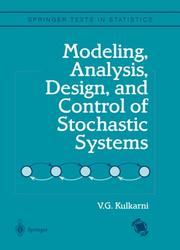
ISBN: 0387987258 1441931546 1475730985 Year: 1999 Publisher: New York : Springer,
Abstract | Keywords | Export | Availability | Bookmark
 Loading...
Loading...Choose an application
- Reference Manager
- EndNote
- RefWorks (Direct export to RefWorks)
This is an introductory level text on stochastic modeling. It is suited for undergraduate or graduate students in actuarial science, business management, computer science, engineering, operations research, public policy, statistics, and mathematics. It employs a large number of examples to teach how to build stochastic models of physical systems, analyze these models to predict their performance, and use the analysis to design and control them. The book provides a self-contained review of the relevant topics in probability theory. The rest of the book is devoted to important classes of stochastic models. In discrete and continuous time Markov models it covers the transient and long term behavior, cost models, and first passage times. Under generalized Markov models, it covers renewal processes, cumulative processes and semi-Markov processes. All the material is illustrated with many examples. There is a separate chapter on queueing models. In the chapter on design the author shows how the techniques developed in the text can be used to optimize the performance of a system. Finally, in the last chapter, linear programming is used to compute optimal control policies for stochastic systems. The book emphasizes numerical answers to the problems. A software package called MAXIM, which runs on MATLAB, is made available for downloading. Vidyadhar G. Kulkarni is Professor of Operations Research at the University of North Craolina at Chapel Hill. He has authored a graduate level text 'Modeling and Analysis of Stochastic Systems' and research articles on stochastic models of queues, computer systems and telecommunication systems. He holds a patent on traffic management in telecommunication networks, and he has served as an editor and associate editor of Stochastic Models and Operations Research Letters.
Stochastic processes --- Stochastic processes. --- Processus stochastiques --- Applied mathematics. --- Engineering mathematics. --- Statistics . --- Probabilities. --- Operations research. --- Decision making. --- Mathematical and Computational Engineering. --- Statistics, general. --- Probability Theory and Stochastic Processes. --- Operations Research/Decision Theory. --- Deciding --- Decision (Psychology) --- Decision analysis --- Decision processes --- Making decisions --- Management --- Management decisions --- Choice (Psychology) --- Problem solving --- Operational analysis --- Operational research --- Industrial engineering --- Management science --- Research --- System theory --- Probability --- Statistical inference --- Combinations --- Mathematics --- Chance --- Least squares --- Mathematical statistics --- Risk --- Statistical analysis --- Statistical data --- Statistical methods --- Statistical science --- Econometrics --- Engineering --- Engineering analysis --- Mathematical analysis --- Decision making --- Random processes --- Probabilities --- Stochastic process
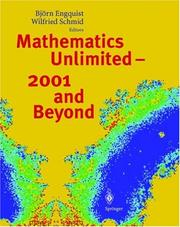
ISBN: 3540669132 3642631142 364256478X 3540670998 9783540669135 Year: 2001 Publisher: Berlin Springer
Abstract | Keywords | Export | Availability | Bookmark
 Loading...
Loading...Choose an application
- Reference Manager
- EndNote
- RefWorks (Direct export to RefWorks)
This is a book guaranteed to delight the reader. It not only depicts the state of mathematics at the end of the century, but is also full of remarkable insights into its future development as we enter a new millennium. True to its title, the book extends beyond the spectrum of mathematics to include contributions from other related sciences. You will enjoy reading the many stimulating contributions and gain insights into the astounding progress of mathematics and the perspectives for its future. One of the editors, B. Engquist, is a world-renowned researcher in computational science and engineering. The second editor, W. Schmid, is a distinguished mathematician at Harvard University. Likewise the authors are all foremost mathematicians and scientists, and their biographies and photographs appear at the end of the book. Unique in both form and content, this is a "must-read" for every mathematician and scientist and, in particular, for graduate students still choosing their speciality.
Mathematics --- wiskunde --- Mathematics. --- Science. --- Mathématiques --- Sciences --- Science --- 51 --- Natural science --- Science of science --- Math --- 51 Mathematics --- Mathématiques --- Natural sciences --- 51 Wiskunde. Mathematiek --- Wiskunde. Mathematiek --- Computer mathematics. --- Computer science—Mathematics. --- Physics. --- Applied mathematics. --- Engineering mathematics. --- Chemometrics. --- Computational Mathematics and Numerical Analysis. --- Mathematics of Computing. --- Mathematical Methods in Physics. --- Numerical and Computational Physics, Simulation. --- Mathematical and Computational Engineering. --- Math. Applications in Chemistry. --- Chemistry, Analytic --- Analytical chemistry --- Chemistry --- Engineering --- Engineering analysis --- Mathematical analysis --- Natural philosophy --- Philosophy, Natural --- Physical sciences --- Dynamics --- Computer mathematics --- Electronic data processing --- Measurement --- Statistical methods
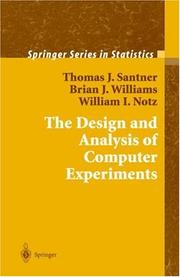
ISBN: 0387954201 1441929924 1475737998 9780387954202 Year: 2003 Publisher: New York, N.Y. Springer
Abstract | Keywords | Export | Availability | Bookmark
 Loading...
Loading...Choose an application
- Reference Manager
- EndNote
- RefWorks (Direct export to RefWorks)
The computer has become an increasingly popular tool for exploring the relationship between a measured response and factors thought to affect the response. In many cases, the basis of a computer model is a mathematical theory that implicitly relates the response to the factors. A computer model becomes possible given suitable numerical methods for accurately solving the mathematical system and appropriate computer hardware and software to implement the numerical methods. For example, in many engineering applications, the relationship is described by a dynamical system and the numerical method is a finite element code. The resulting computer "simulator" can generate the response corresponding to any given set of values of the factors. This allows one to use the code to conduct a "computer experiment" to explore the relationship between the response and the factors. In some cases, computer experimentation is feasible when a properly designed physical experiment (the gold standard for establishing cause and effect) is impossible; the number of input variables may be too large to consider performing a physical experiment, or power studies may show it is economically prohibitive to run an experiment on the scale required to answer a given research question. This book describes methods for designing and analyzing experiments that are conducted using a computer code rather than a physical experiment. It discusses how to select the values of the factors at which to run the code (the design of the computer experiment) in light of the research objectives of the experimenter. It also provides techniques for analyzing the resulting data so as to achieve these research goals. It illustrates these methods with code that is available to the reader at the companion web site for the book. Thomas Santner has been a professor in the Department of Statistics at The Ohio State University since 1990. At Ohio State, he has served as department Chair and Director of the department's Statistical Consulting Service. Previously, he was a professor in the School of Operations Research and Industrial Engineering at Cornell University. He is a Fellow of the American Statistical Association and the Institute of Mathematical Statistics, and is an elected ordinary member of the International Statistical Institute. He visited Ludwig Maximilians Universität in Munich, Germany on a Fulbright Scholarship in 1996-97. Brian Williams has been an Associate Statistician at the RAND Corporation since 2000. His research interests include experimental design, computer experiments, Bayesian inference, spatial statistics and statistical computing. He holds a Ph.D. in statistics from The Ohio State University. William Notz is a professor in the Department of Statistics at The Ohio State University. At Ohio State, he has served as acting department chair, associate dean of the College of Mathematical and Physical Sciences, and as director of the department's Statistical Consulting Service. He has also served as Editor of the journal Technometrics and is a Fellow of the American Statistical Association. .
Mathematical statistics --- Experimental design --- Physical sciences --- Experiments --- Computer simulation --- Computer mathematics. --- Computer simulation. --- Applied mathematics. --- Engineering mathematics. --- Statistics . --- Computational Mathematics and Numerical Analysis. --- Simulation and Modeling. --- Mathematical and Computational Engineering. --- Statistical Theory and Methods. --- Statistics for Engineering, Physics, Computer Science, Chemistry and Earth Sciences. --- Statistical analysis --- Statistical data --- Statistical methods --- Statistical science --- Mathematics --- Econometrics --- Engineering --- Engineering analysis --- Mathematical analysis --- Computer modeling --- Computer models --- Modeling, Computer --- Models, Computer --- Simulation, Computer --- Electromechanical analogies --- Mathematical models --- Simulation methods --- Model-integrated computing --- Computer mathematics --- Electronic data processing --- Physical sciences - Experiments - Computer simulation
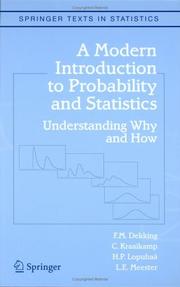
ISBN: 1852338962 9781852338961 1849969523 1846281687 Year: 2005 Publisher: London : Springer London : Imprint: Springer,
Abstract | Keywords | Export | Availability | Bookmark
 Loading...
Loading...Choose an application
- Reference Manager
- EndNote
- RefWorks (Direct export to RefWorks)
Probability and Statistics are studied by most science students, usually as a second- or third-year course. Many current texts in the area are just cookbooks and, as a result, students do not know why they perform the methods they are taught, or why the methods work. The strength of this book is that it readdresses these shortcomings; by using examples, often from real-life and using real data, the authors can show how the fundamentals of probabilistic and statistical theories arise intuitively. It provides a tried and tested, self-contained course, that can also be used for self-study. A Modern Introduction to Probability and Statistics has numerous quick exercises to give direct feedback to the students. In addition the book contains over 350 exercises, half of which have answers, of which half have full solutions. A website at www.springeronline.com/1-85233-896-2 gives access to the data files used in the text, and, for instructors, the remaining solutions. The only pre-requisite for the book is a first course in calculus; the text covers standard statistics and probability material, and develops beyond traditional parametric models to the Poisson process, and on to useful modern methods such as the bootstrap. This will be a key text for undergraduates in Computer Science, Physics, Mathematics, Chemistry, Biology and Business Studies who are studying a mathematical statistics course, and also for more intensive engineering statistics courses for undergraduates in all engineering subjects.
Mathematical statistics --- Probability theory --- Probabilities --- Probabilités --- Statistique mathématique --- Handbooks, manuals, etc. --- Guides, manuels, etc --- Harmonic analysis. --- Mathematical statistics -- Textbooks. --- Probabilities -- Textbooks. --- Probabilities. --- Stochastic analysis. --- Mathematical Statistics --- Mathematics --- Physical Sciences & Mathematics --- Probabilités --- Statistique mathématique --- EPUB-LIV-FT LIVSTATI SPRINGER-B --- Probability --- Statistical inference --- Mathematics. --- Statistics. --- Applied mathematics. --- Engineering mathematics. --- Probability Theory and Stochastic Processes. --- Statistics for Engineering, Physics, Computer Science, Chemistry and Earth Sciences. --- Appl.Mathematics/Computational Methods of Engineering. --- Combinations --- Chance --- Least squares --- Risk --- Distribution (Probability theory. --- Mathematical and Computational Engineering. --- Engineering --- Engineering analysis --- Mathematical analysis --- Statistical analysis --- Statistical data --- Statistical methods --- Statistical science --- Econometrics --- Distribution functions --- Frequency distribution --- Characteristic functions --- Statistics . --- Probabilités. --- Statistique mathématique.
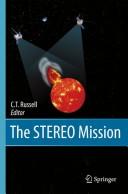
ISBN: 3540096485 3642618693 0387096485 0387096493 3540096620 9783642618697 9783540096481 9780387096490 Year: 2008 Publisher: New York : Springer,
Abstract | Keywords | Export | Availability | Bookmark
 Loading...
Loading...Choose an application
- Reference Manager
- EndNote
- RefWorks (Direct export to RefWorks)
From the reviews: "...Here we have a book which we can wholeheartedly suggest. The mathematics is sound and pared to essentials; the examples are an impressive, well-chosen selection from the biomathematics literature, and the problem sets provide both useful exercises and some fine introductions to the art of modeling... Batschelet has written an introduction to biomathematics which is notable for its clarity - not only a clarity of presentation, but also a clarity of purpose, backed by a sure grasp of the field..." #Bulletin of Mathematical Biology#1 "For research workers in the biomedical field who feel a need for freshening up their knowledge in mathematics, but so far have always been frustrated by either too formal or too boring textbooks, there is now exactly what they would like to have: an easy to read introduction. This book is highly motivating for practical workers because only those mathematical techniques are offered for which there is an application in the life sciences. The reader will find it stimulating that each tool described is immediately exemplified by problems from latest publications." #Int. Zeitschrift für klinische Pharmakologie, Therapie und Toxikologie#2.
Astrophysics. --- Heliosphere (Ionosphere) -- Research. --- Orbiting solar observatories. --- Physics. --- Sun -- Corona -- Research. --- Biology --- Health & Biological Sciences --- Biology - General --- Biomathematics. --- Mathematics --- Engineering. --- Life sciences. --- Applied mathematics. --- Engineering mathematics. --- Appl.Mathematics/Computational Methods of Engineering. --- Mathematical and Computational Biology. --- Life Sciences, general. --- Biomathematics. Biometry. Biostatistics --- Mathematical and Computational Engineering. --- Biosciences --- Sciences, Life --- Science --- Engineering --- Engineering analysis --- Mathematical analysis --- Solar-terrestrial physics. --- Photography, Stereoscopic. --- Geophysics. --- Geological physics --- Terrestrial physics --- Earth sciences --- Physics --- Stereophotography --- Stereoscopic photography --- Three-dimensional imaging --- Solar terrestrial interactions --- Solar-terrestrial relations --- Sun-Earth connection --- Terrestrial-solar relations --- Geophysics --- Solar activity

ISBN: 0817638644 3764338644 1461268761 1461207096 9780817638641 Year: 1997 Publisher: Boston Birkhäuser
Abstract | Keywords | Export | Availability | Bookmark
 Loading...
Loading...Choose an application
- Reference Manager
- EndNote
- RefWorks (Direct export to RefWorks)
I once heard the book by Meyer (1993) described as a "vulgarization" of wavelets. While this is true in one sense of the word, that of making a sub ject popular (Meyer's book is one of the early works written with the non specialist in mind), the implication seems to be that such an attempt some how cheapens or coarsens the subject. I have to disagree that popularity goes hand-in-hand with debasement. is certainly a beautiful theory underlying wavelet analysis, there is While there plenty of beauty left over for the applications of wavelet methods. This book is also written for the non-specialist, and therefore its main thrust is toward wavelet applications. Enough theory is given to help the reader gain a basic understanding of how wavelets work in practice, but much of the theory can be presented using only a basic level of mathematics. Only one theorem is for mally stated in this book, with only one proof. And these are only included to introduce some key concepts in a natural way.
Mathematical statistics --- Wavelets (Mathematics) --- Ondelettes --- Statistique mathématique --- 519.23 --- 519.25 --- 517.518.3 --- #WWIS:didaktiek --- Wavelet analysis --- Harmonic analysis --- Mathematics --- Statistical inference --- Statistics, Mathematical --- Statistics --- Probabilities --- Sampling (Statistics) --- Statistical analysis. Inference methods --- Statistical data handling --- Systems of functions. Series in systems of functions --- Statistical methods --- 517.518.3 Systems of functions. Series in systems of functions --- 519.25 Statistical data handling --- 519.23 Statistical analysis. Inference methods --- Statistique mathématique --- Applied mathematics. --- Engineering mathematics. --- Signal processing. --- Image processing. --- Speech processing systems. --- Approximation theory. --- Mathematical and Computational Engineering. --- Signal, Image and Speech Processing. --- Approximations and Expansions. --- Applications of Mathematics. --- Processing, Signal --- Information measurement --- Signal theory (Telecommunication) --- Engineering --- Engineering analysis --- Mathematical analysis --- Theory of approximation --- Functional analysis --- Functions --- Polynomials --- Chebyshev systems --- Computational linguistics --- Electronic systems --- Information theory --- Modulation theory --- Oral communication --- Speech --- Telecommunication --- Singing voice synthesizers --- Pictorial data processing --- Picture processing --- Processing, Image --- Imaging systems --- Optical data processing --- Mathematical statistics.
| Listing 1 - 10 of 15 | << page >> |
Sort by
|

 Search
Search Feedback
Feedback About
About Help
Help News
News